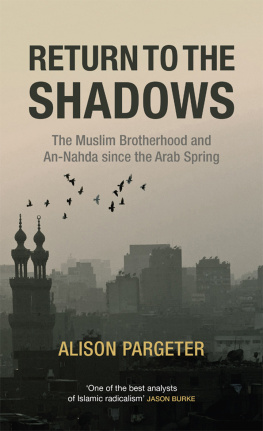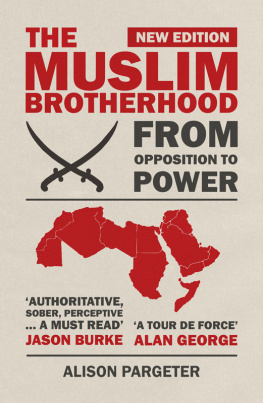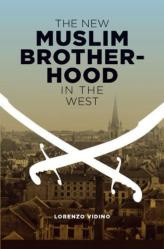RETURN TO THE SHADOWS
ALSO BY ALISON PARGETER
The New Frontiers of Jihad: Radical Islam in Europe
The Muslim Brotherhood: From Opposition to Power
Libya: The Rise and Fall of Qaddafi
RETURN TO THE SHADOWS
The Muslim Brotherhood
and An-Nahda since the Arab Spring
ALISON PARGETER
SAQI
Published 2016 by Saqi Books
Copyright Alison Pargeter 2016
Alison Pargeter has asserted her right under the Copyright, Designs and Patents Act, 1988, to be identified as the author of this work.
This book is sold subject to the condition that it shall not, by way of trade or otherwise, be lent, resold, hired out, or otherwise circulated without the publishers prior consent in any form of binding or cover other than that in which it is published and without a similar condition including this condition being imposed on the subsequent purchaser.
ISBN 978-0-86356-144-3
eISBN 978-0-86356-154-2
A full cip record for this book is available from the British Library.
Printed and bound by CPI Mackays, Chatham, ME5 8TD
Saqi Books
26 Westbourne Grove
London W2 5RH
www.saqibooks.com
CONTENTS
ACKNOWLEDGMENTS
This book was made possible by a research grant from the Smith Richardson Foundation. This generous support enabled me to build on my previous work on the Muslim Brotherhood and to examine the movement and its counterparts following the tumultuous events of the Arab Spring. In particular it enabled me to conduct primary research on the Muslim Brotherhood in Egypt and Libya, and on An-Nahda in Tunisia, through a number of research visits to the region and beyond. As a result, much of this book is based on interviews carried out with members of these movements, as well as with specialists and experts in the field. In particular I would like to thank Nadia Schadlow from the Smith Richardson Foundation for her continued support for my research on the Brotherhood. I also thank her for her patience. The research project was conceived at a time when the Brotherhood had recently come to power in Egypt but was delayed to accommodate the dramatically changing circumstances on the ground. I am very grateful to have been given the space to carry out this project at such an important time.
I would also like to thank the Airey Neave Trust and the Dulverton Trust, both of which also supported this project with research grants. They provided funding that enabled me to extend my research, and in particular to carry out additional field visits. This proved particularly invaluable given that key leaders from the Egyptian Brotherhood ended up being displaced across the region. My thanks also go to the Royal United Services Institute, and to Professor Michael Clarke in particular, for being willing to host this project and to support my research.
I would also like to thank Lynn Gaspard and Sarah Cleave at Saqi Books for supporting this book and for all their help and patience. I am also hugely grateful to Charles Peyton for copy-editing the text.
I am deeply indebted to all those individuals who were willing to be interviewed for this book, particularly those from the Muslim Brotherhood and from An-Nahda. In particular I would like to thank Osama Haddad and Mohamed Soudan from the Egyptian Brotherhood, Mohamed Abdulmalik and Alamin Belhaj from the Libyan Brotherhood, and Amer Larayedh, Said Ferjani and Walid Bannani from An-Nahda. I thank them for their frankness, kindness and generosity. Special thanks go to Professor Alaya Allani and Professor Mehdi Mabrouk for all their help, kindness and, most importantly, their insights, during my visits to Tunisia. I would also like to thank Shafiq Gabr for his interest in my work and his assistance in facilitating interviews in Egypt, as well as for his insights. Lastly, I would like to thank all those individuals whose names I cannot mention but whose assistance has been indispensable.
INTRODUCTION
As Mohamed Morsi stepped up to the presidency on 30 June 2012, the world, or at least the Middle East, appeared to have changed irreversibly. After more than eight decades in the shadows of semi-clandestinity, the Muslim Brotherhood, a Sunni fundamentalist movement long considered to be the vanguard of political Islamism, had finally come to the fore. More importantly, it had done so through the ballot box. Following the uprisings that erupted in Egypt on 25 January 2011, leading to President Hosni Mubaraks ousting the following month, the Brotherhood, by virtue of being the only organised force in the country, moved quickly to fill the vacuum that had opened up. The Brotherhoods Freedom and Justice Party (FJP) won the publics support in both parliamentary and presidential elections, and was poised to put its project into action. This was a deeply symbolic moment for the Brotherhood and for the Islamic movement more widely. As the pioneer of political Islam, the Brotherhood at last had the opportunity to demonstrate that an Islamist party could lead an Arab state in the contemporary era. More importantly, it had a chance to steer Egypt down a different path, breaking the hold of the military-backed regime that had ruled for generations, and to reconnect society to what the movement deemed to be its authentic self.
It had been a very long wait. Established in 1928 in Ismailia by schoolteacher Hassan Al-Banna, the Muslim Brotherhood had a history of patience and persecution. It started out as a socio-religious movement chiefly preoccupied with how to confront the challenges of modernisation, and what Al-Banna saw as the spiritual and moral decline of the Ummah (united Muslim nation). Drawing on the ideas of the reformist thinkers of the nineteenth century, Al-Banna believed that the only way to counter such challenges was to reform society by returning to the ideal Islamic society of the past. Al-Bannas was a project of salvation aimed at putting Islam at the centre of things.
As it developed, the Brotherhood became more directly involved in politics, soon emerging as the most powerful opposition force not only in Egypt but across the region, where branches of the movement had sprung up. Inevitably, therefore, it came to clash with the secular nationalist regimes of the day, and found itself subjected to heavy repression. Not that it had ever been a movement that claimed to want to rule. Participation not domination was its famous mantra a phrase that was to be repeated again and again by senior Brotherhood leaders during the course of 2011. In fact, the Brotherhood invested significant energy over the years trying to signal that it was not power-hungry, but could work within the existing framework of the state. This was part of its almost schizophrenic approach that mixed appeasement and compromise on the one hand with opposition politics on the other, the aim being to carve out as much space as possible in which it could operate.
Moreover, the Brotherhood was a movement characterised by gradualism, believing that reforming society began with reforming the individual. Its project was a long-term one something that elicited the condemnation of more militant elements over the years who, impatient for action, broke away to form their own groups. While the Brotherhoods gradualist stance enabled it to outlive many of these more radical and hot-headed offshoots, by the eve of the 2011 uprisings its long years of waiting were taking their toll. Indeed, this large, unwieldy body was proving unable to break free from its own traditions in order to meet the challenges of operating as a modern body in a modern age. Its attempts at reforming itself in the 2000s had born little fruit and the movement appeared to be on the retreat from politics rather than the opposite.












